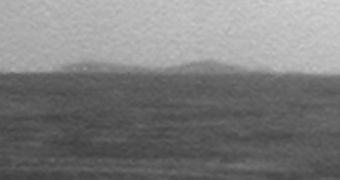The resilient Mars rover has managed just recently to get a first glimpse of its destination, the Endeavor crater, towards which the robot has been traveling for more than 6 months. It's panoramic cameras have revealed the uplifted rim of the large crater, still a good distance away from the rover's current position.
Currently, both of NASA's Martian explorers are on-route to their objectives. Spirit still has a long way to go before it reaches a plateau, where it's supposed to spend the next Martian winter, But last week it was forced to take the long way around to get there, as treacherous terrain didn't allow for a straight course.
The Endeavor crater is still a good 14 miles (22 kilometers) away from Opportunity in a straight line, although the actual course of the rover will make this distance at least 30 percent longer. The robot has to maneuver carefully on the surface of the Red Planet, as loose gravel can easily slide and take the explorer with it. Any damage to the fragile solar arrays would result in sudden death for the probe, and NASA mission managers have no intention of letting that happen.
The two machines have already exceeded all expectations as to their life span, and with each passing day they become more and more of a phenomenon. Originally meant to roam the Martian surface for just three months, both Spirit and Opportunity have managed to survive not one, but 4 Martian winters, and are now well into their fifth year of operation. They have basically fulfilled the tasks of numerous other missions, and have spared NASA a huge sum of money that the agency would have otherwise had to spend on new rovers, on planning and on delivery systems.
“It's exciting to see our destination, even if we can't be certain whether we'll ever get all the way there. At the pace we've made since leaving Victoria, the rest of the trek will take more than a Martian year (23 Earth months),” John Callas, the manager of the rover project, says from the Jet Propulsion Laboratory (JPL) in Pasadena, California.
“We're stopping to taste the terrain at intervals along our route so that we can watch for trends in the composition of the soil and bedrock. It's part of systematic exploration,” the rovers' science instruments principal investigator Steve Squyres, an expert from the Cornell University, adds.
Spirit also has a challenging time ahead, NASA officials tell. “After several attempts to drive up-slope in loose material to get around the northeast corner of Home Plate, the team judged that route to be impassable,” Callas underlines. “The western route is by no means a slam dunk. It is unexplored territory. There are no rover tracks on that side of Home Plate like there are on the eastern side. But that also makes it an appealing place to explore. Every time we've gone someplace new with Spirit since we got into the hills, we've found surprises,” Squyres concludes.

 14 DAY TRIAL //
14 DAY TRIAL //